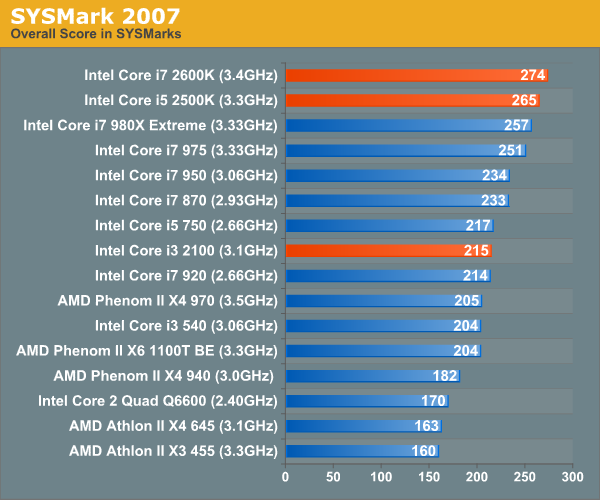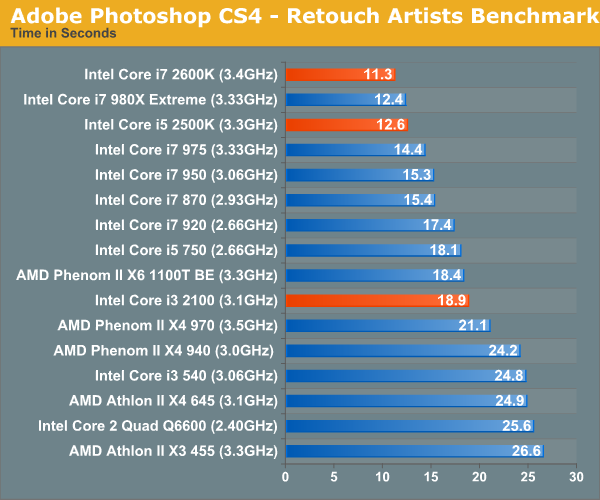The Sandy Bridge Review: Intel Core i7-2600K, i5-2500K and Core i3-2100 Tested
by Anand Lal Shimpi on January 3, 2011 12:01 AM ESTGeneral Performance: SYSMark 2007
Our journey starts with SYSMark 2007, the only all-encompassing performance suite in our review today. The idea here is simple: one benchmark to indicate the overall performance of your machine. SYSMark 2007 ends up being more of a dual-core benchmark as the applications/workload show minimal use of more than two threads.

The 2600K is our new champion, the $317 chip is faster than Intel's Core i7 980X here as SYSMark 2007 doesn't really do much with the latter's extra 2 cores. Even the 2500K is a hair faster than the 980X. Compared to the Core i5 750, the upgrade is a no brainer - Sandy Bridge is around 20% faster at the same price point as Lynnfield.
Compared to Clarkdale, the Core i3 2100 only manages a 5% advantage howeer.
Adobe Photoshop CS4 Performance
To measure performance under Photoshop CS4 we turn to the Retouch Artists’ Speed Test. The test does basic photo editing; there are a couple of color space conversions, many layer creations, color curve adjustment, image and canvas size adjustment, unsharp mask, and finally a gaussian blur performed on the entire image.
The whole process is timed and thanks to the use of Intel's X25-M SSD as our test bed hard drive, performance is far more predictable than back when we used to test on mechanical disks.
Time is reported in seconds and the lower numbers mean better performance. The test is multithreaded and can hit all four cores in a quad-core machine.

Once again, we have a new king - the 2600K is 9.7% faster than the 980X in our Photoshop CS4 test and the 2500K is just about equal to it. The Core i3 2100 does much better compared to the i3 540, outpacing it by around 30% and nearly equaling the performance of AMD's Phenom II X6 1100T.










283 Comments
View All Comments
vol7ron - Monday, January 3, 2011 - link
I'm also curious if there will be a hybrid P/H type mobo that will allow for OC'ing all components.sviola - Monday, January 3, 2011 - link
Yes. There will be a Z series to be released in the 2Q11.dacipher - Monday, January 3, 2011 - link
The Core i5-2500K was just what i was looking for. Performance/ Price is where it needs to be and overclocking should be a breeze.vol7ron - Monday, January 3, 2011 - link
I agree."As an added bonus, both K-series SKUs get Intel’s HD Graphics 3000, while the non-K series SKUs are left with the lower HD Graphics 2000 GPU."
Doesn't it seem like Intel has this backwards? For me, I'd think to put the 3000 on the lesser performing CPUs. Users will probably have their own graphics to use with the unlocked procs, whereas the limit-locked ones will more likely be used in HTPC-like machines.
DanNeely - Monday, January 3, 2011 - link
This seems odd to me unless they're having yield problems with the GPU portion of their desktop chips. That doesn't seem too likely though because you'd expect the mobile version to have the same problem but they're all 12 EU parts. Perhaps they're binning more aggressively on TDP, and only had enough chips that met target with all 12 EUs to offer them at the top of the chart.dananski - Monday, January 3, 2011 - link
I agree with both of you. This should be the ultimate upgrade for my E8400, but I can't help thinking they could've made it even better if they'd used the die space for more CPU and less graphics and video decode. The Quick Sync feature would be awesome if it could work while you're using a discrete card, but for most people who have discrete graphics, this and the HD Graphics 3000 are a complete waste of transistors. I suppose they're power gated off so the thermal headroom could maybe be used for overclocking.JE_Delta - Monday, January 3, 2011 - link
WOW........Great review guys!
vol7ron - Monday, January 3, 2011 - link
Great review, but does anyone know how often 1 active core is used. I know this is a matter of subjection, but if you're running an anti-virus and have a bunch of standard services running in the background, are you likely to use only one core when idling?What should I advise people, as consumers, to really pay attention to? I know when playing games such as Counter-Strike or Battlefield: Bad Company 2, my C2D maxes out at 100%, I assume both cores are being used to achieve the 100% utilization. I'd imagine that in this age, hardly ever will there be a time to use just one core; probably 2 cores at idle.
I would think that the 3-core figures are where the real noticeable impact is, especially in turbo, when gaming/browsing. Does anyone have any more perceived input on this?
dualsmp - Monday, January 3, 2011 - link
What resolution is tested under Gaming Performance on pg. 20?johnlewis - Monday, January 3, 2011 - link
According to Bench, it looks like he used 1680×1050 for L4D, Fallout 3, Far Cry 2, Crysis Warhead, Dragon Age Origins, and Dawn of War 2, and 1024×768 for StarCraft 2. I couldn't find the tested resolution for World of Warcraft or Civilization V. I don't know why he didn't list the resolutions anywhere in the article or the graphs themselves, however.